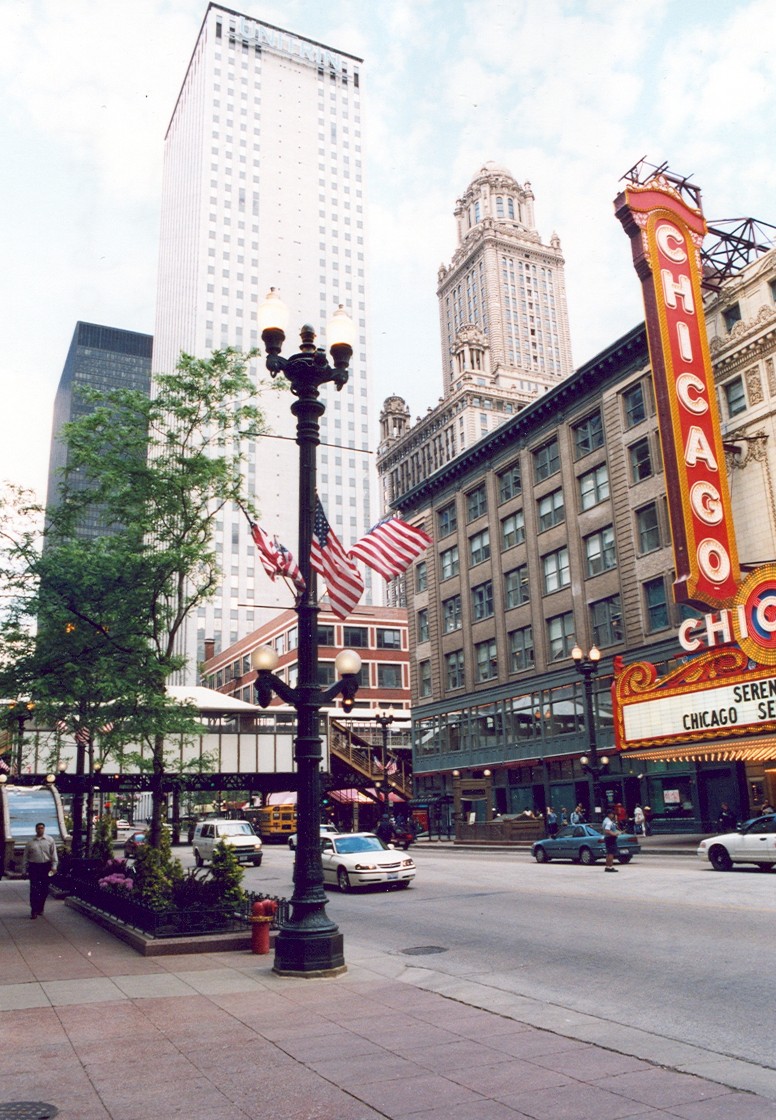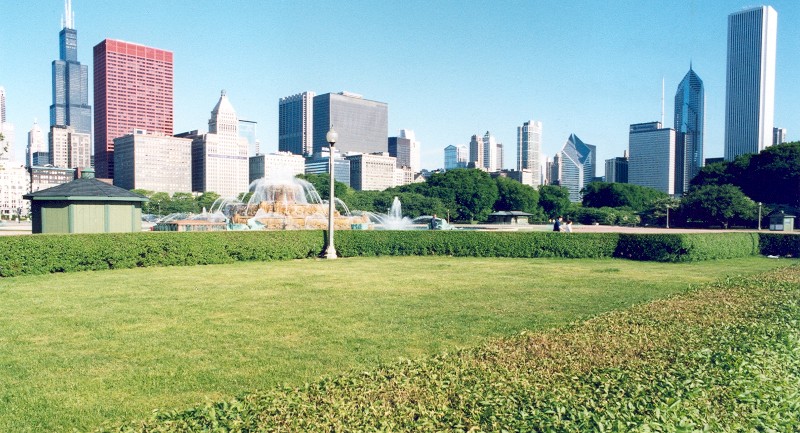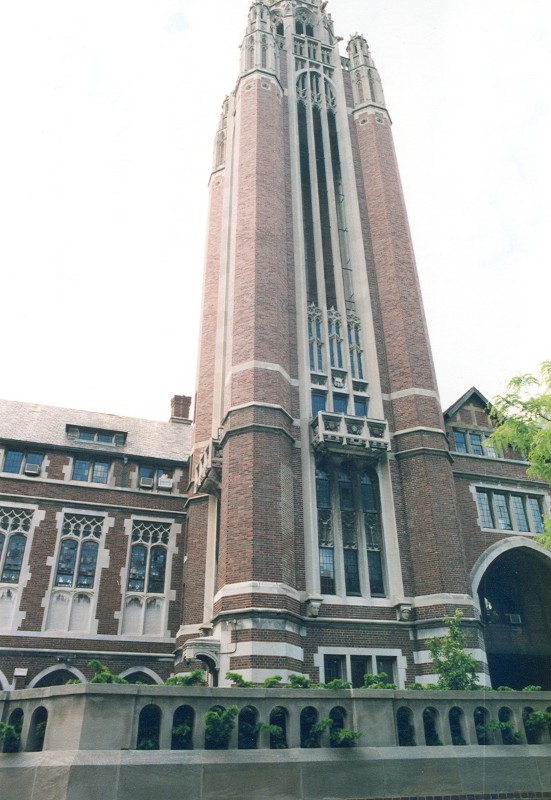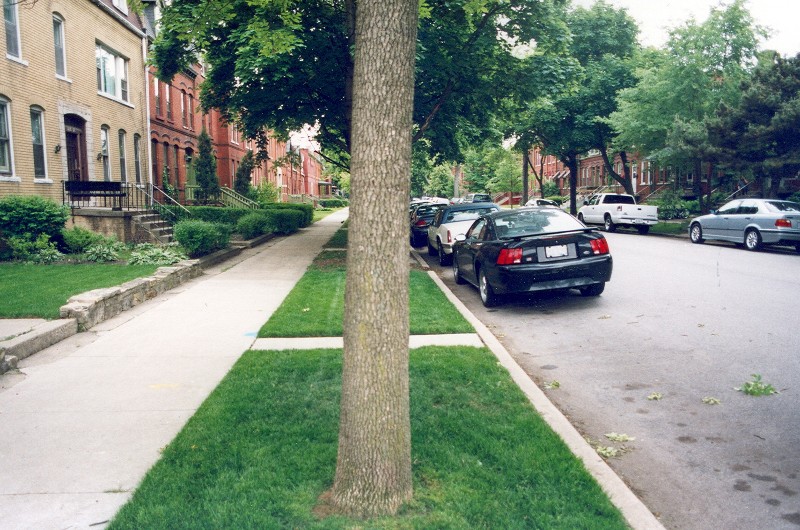Chicago (May 2005)
![]()

Maureen asks me to join her for a trip she is making to Chicago this Memorial Day weekend. I happily agree to join her. Like countless other Americans, I've "been to Chicago" several times. But only in the sense that I fly occasionally. Inevitably for American flyers, "been to Chicago" simply means that my flight touched down at O'Hare International briefly so that I could transfer to another plane. For many, then, "been to Chicago" merely points out that we've seen the terminal of this major hub airport. Not much to write home about.
This time, though, it would be different. Now, for the first time, I will actually be leaving the airport.
And for an adventurer like me, that means I need to pore through a number of guidebooks and consult with various Chicago-experienced friends for recommendations. Ultimately, my list of "things to do" in Chicago is a list of the 50-60 "must see" features in this city full of lore.
Speaking of lore, I learn in my research that "The Windy City" refers not to blustery weather conditions in Chicago, but the fact that long ago, the City was promoting itself so promiscuously that it was chided by one major American newspaper as being "windy."
A friend who will join me there has a look at my Chicago "to do" list, and bursts out laughing. "You'll need about 3 MONTHS to see all those places, not the 3 DAYS you will be there," he says after seeing my absurdly ambitious itinerary.
But he forgets my weapons: Years of adventure experience. Being an Energizer Bunny. And knowledge that a high-quality metro train system can cover quite a bit of ground rather efficiently (and affordably).
Three months? On the contrary, I am now prepared to write a new guidebook: "Chicago in 3 DAYS."
We start with the obligatory trip to an authentic city microbrewery. Rock Bottom has a splendid selection of high-quality beer brewed on the premises. Best of all, the "red line" subway has a stop right in front of the pub. This time of year, the place was proudly serving their Irish Stout. Outstanding quality. In other times of year, they prepare an oatmeal stout. That being my favorite stout, I'll need to be a return customer. We also sample their lunch menu, which is quite good. I particularly recommend their Mahi Taco and their Grilled Salmon Sandwich.
In my whirlwind Chicago travels over the next few days, I use quite a bit of their rail transit system. While I found their subway fairly decrepit and dirty, it seemed to function well enough in the ways it needs to: ticketing, speed, comprehensiveness, affordability and coverage. While there, I sample not only the subway, but "the El" - the well-known elevated train that loops around the perimeter of the famous Chicago Loop downtown.
Maureen and I stay at the Conrad Hilton downtown. The Hilton towers over Grant Park, which sits adjacent to its east on Michigan Avenue. Inside, I find that the lobby ceiling and the Grand Ballroom are simply magnificent.
For lunch, the three of us go to perhaps the most famous restaurant institution in Chicago - The Berghoff. The inside of the restaurant is graced with impressive woodwork, and the restaurant has the quite unique distinction of employing its own full-time staff of carpenters to maintain it. The food here, we discover, is excellent and surprisingly affordable. The wait staff very classy, skilled and efficient. The ambience is pleasantly traditional.
After lunch, we visit the Rookery Building, which features an exceptional and quite memorable domed ceiling designed by Frank Lloyd Wright. Next, we stop in at the Palmer House Hilton, which has a lobby ceiling boasting a spectacular display of French impressionist paintings. Likewise, the Chicago Cultural Center also has wondrous ceilings that boggle our minds as we gaze up.
We walk the "magnificent mile" - a well-known retail street in the north downtown area on our way to lunch. Not being a shopper, I was not particularly struck by its "magnificence."
Soon, we arrive at the "world famous Billy Goat Tavern," made internationally famous by John Belushi and Dan Ackroyd, who parodied the place in their Saturday Night Live skit in which short-order cooks respond to customers by shouting "Cheezeborger!! Cheezeborger!! NO FRIES!! CHEEPS!!! While sipping a mug of Billy Goat Dark Ale - a beer I would rate as somewhat mediocre - I imagine Belushi and Ackroyd behind the counter as they caricatured the place back in the 1970s.
On the recommendation of our friend, Maureen and I settle on Exchequer Restaurant & Pub for dinner (after giving up, for the second time this weekend, on "Pizzeria Uno" - famed for originating the deep dish Chicago-style pizza - because the wait both times was over an hour). The Pub turns out to be a surprisingly wise, worthy choice. This little business serves large portions of low-cost but high quality appetizers and deep dish pizza. Despite my notoriously large appetite (my reputation is that I can eat what two or three large men can eat at a dinner table) and my famished condition, the waiter advises that I will not be able to eat more than a small-size deep dish (I had considered ordering a large before his warning). He was, of course, correct, I soon learned. I waddle out of the place with respect for how filling and high quality they are.
First thing Saturday morning, Maureen and I run Grant Park and Millennium Park (including Frank Gehry's bizarre Pritzker Pavilion) next to our hotel. In Grant, I try to imagine the scene in 1968 at the Democratic National Convention, where a "police riot" saw Chicago's finest chasing and clubbing and mace-ing "YIPPIES" who had assembled in Grant Park to protest the Convention. For a brief instant, I could picture the wild hair of Abbie Hoffman and Jerry Rubin as they rushed around in a crazed, chaotic scene at Grant.

From the park, one has a stupendous view of the Chicago skyline, and after the run, I return with my camera to shoot it in the morning sun. Afterwards, we ride The El, which is surprisingly high quality and not the rickety, rumbling experience I was expecting. Somewhat like the smooth ride experienced on a light rail system.
Inside Marshall Fields, an enormous department store taking up an entire city block and several stories in height, I am astonished to look up the several stories of atriums and ceilings. Quite impressive for a department store.
We are whisked by train to the Old Town neighborhood, which is graced with an enviable collection of historic rowhouses. Next door, we stroll down Astor Street to see the famous mansions, which are remarkable. On the next street over (State Street), we visit the former Playboy Mansion (a surprisingly unassuming rowhouse building that formerly housed Hugh Hefner and his bunnies).
Around the corner, we explore the Lincoln Park neighborhood, which contains outstanding rowhouses similar to what we see in Old Town. I remark to my friend that I could easily see myself living in a number of Chicago neighborhoods, which surprises me as I had no prior awareness of the many high-quality neighborhoods found in this city.

During our travels this day, we are both impressed by the large number of Cubs baseball fans and World Cup soccer (US vs England) fans jamming the subways and The El.
We then train to Beer Baron Row, a rowhouse neighborhood formerly inhabited by the major captains of beer-making in Chicago's brewing past.
Next, we train down to the University of Chicago campus (known more for its Nobel Laurent's than its athletes). The campus is compact and contains a number of impressive Gothic academic buildings and residence halls. Leafy commons and ivy certainly create a stereotypical image of a great university here.
At day's end, we shake our heads in amazement. We had just toured - mostly by walking, but also with the help of many train rides - a great many sights in Chicago. We both sleep soundly this night.
For dinner, we eat at the well-known Italian Village restaurant. Again, outstanding, authentic food at very reasonable prices.
Sunday morning, my first destination is the "Ride the (Lakeshore) Drive" bike festival being held at Grant Park. Last year, the event drew over 16,000 riders to ride the 30-mile route. This year, with the perfect weather, I'd not be surprised to learn it was over 20,000 riders.
For lunch, we go to Giordano's in Hyde Park. Rated the best pizza for the past 8 years, I order their stuffed spinach pizza. Simply superb. My mouth still waters as I think back to this delicious pizza.

We take a brief walk through the very impressive Hyde Park Victorians and rowhouses near the University of Chicago campus.
The infamous "South Side of Chicago," sadly, continues to struggle. It remains a scene of bombed out buildings, vacant lots, and a place showing obvious signs of economic and neighborhood decline.
Both my friend and I, for a while now, have had the desire to visit the Town of Pullman, well-known as the place built in the 1880s where a railroad baron built a Utopian community designed to be a beautiful place where his train employees would be better workers because of the quality neighborhoods and housing they lived in (George Pullman was founder of the Pullman Palace Car Company in 1867). It was, in fact, the first planned industrial town in America. Rail cars were built in the town.
Up till now, I had not expected much, frankly. My expectations were that Mr. Pullman was a naïve Utopian who designed a town without any knowledge of how a town worked, and that what I would therefore find would be a goofy, bizarre place that needed to be bulldozed.
But what we instead discover is that Pullman was actually quite good at adopting many of the timeless traditional town-making principles. His neighborhoods use classic rowhouse design. Streets are lined with leafy trees and are very walkable. Manufacturing/industry is close by. The town was served by trains. What appeared to be a market square was bounded by very impressive arcade buildings surrounding it. The public square was very appropriately bounded on all four sides, as are the best town squares, by streets. A bank, library, theatre, post office, church, parks and recreational facilities were provided as part of the town. In 1896, Pullman was presented an award for the "Worlds Most Perfect Town". The town prospered for fourteen years until the depression of 1893-94 about the time of the worlds fair.
In 1960, the town was threatened with total demolition by developers for an industrial park. With the support of the residents, the Pullman Civic Organization was formed and defeated this plan. Through the effort of numerous Pullman residents, Pullman became a State Landmark in 1969, a National Landmark District in 1971, and a City of Chicago Landmark in 1972.

Sadly, the jobs and retail have left Pullman, leaving what appears to be just a shell of its day in the sun.
Of course, had modern day Utopians attempted to build a worker Utopia, the town-building traditions followed by Pullman would have been ignored and a forgettable collection of goofy, dysfunctional, "innovatively modern" buildings in need of bulldozing would have been built.
Next stop is the Museum of Science and Industry. We are fortunate to visit this weekend, as the featured exhibit is "Body Worlds." A fascinating display of the human body. "The Anatomical Exhibition of Real Human Bodies."
The exhibit features bodies that are "exploded" by "plasticizing" the various bones, organs, nerves, muscles and blood vessels of the human body. Muscles and organs are splayed outward to allow glimpses of these features and body cavities behind them. I was particularly impressed by the dense network of blood vessels in the body. I have not yet decided if I will donate my body to science to have it immortalized for all eternity by having it plasticized. Talk about being FULLY exposed!...
That night, the three of us go to the Greek Islands restaurant in the Greek neighborhood of Chicago. Once again, we find the place very authentic, affordable, and filling.
After dinner, we go to see the Buckingham Fountain, which is now lit up with a vast collection of colorful lights. We stand to the south of the fountain. Immediately to the left of the dancing, multi-colored fountain is the striking Chicago skylight, which at night is a sight to behold. Flanked to the right of the fountain is the nightly fireworks display over Lake Michigan. An exceptionally staggering, unforgettable, romantic nighttime display in downtown Chicago.
We then head for Buddy Guy's nightclub for an hour of hot jazz.
On our final day, we train and trolly to Navy Pier. From there, we bike for about 5 miles along Lakeshore Drive bike path north of downtown. The delightful Memorial Day weekend weather brings out an enormous number of rollerbladers, walkers, bicyclists, and joggers (including Lakeshore Marathon runners). Somehow, we manage to dodge all of them on our first attempt at riding a tandem bicycle, which we find to be anything but nimble.
We are stunned to see the Chicago skyline looming next to us and behind us (and dwarfing us) as we chug along in tandem.
Chicago in 3 days? You bet!
Back to Dom's Voyages and Adventures page.